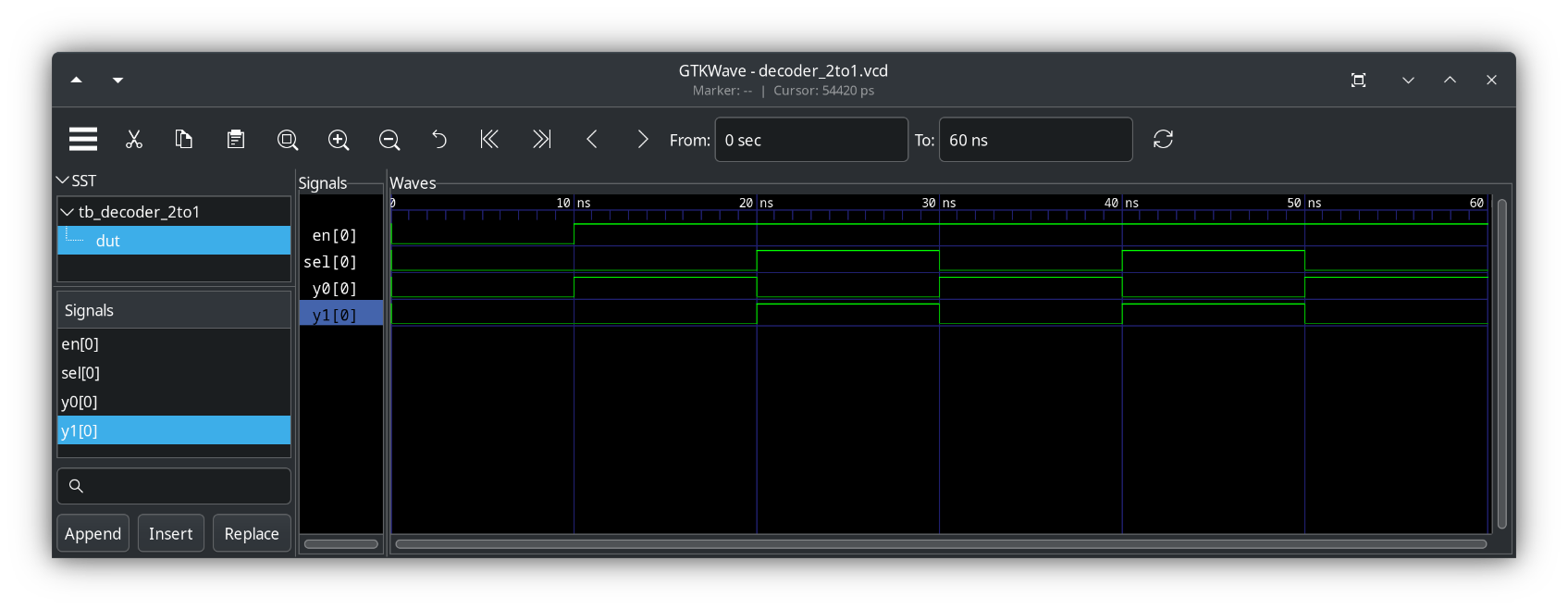Courses & Projects by Rob Marano
Notes for Week 2
← back to syllabus ← back to notes
Topics
- Built-in primitives
- User-defined primitives
- Dataflow modeling
Topics Deep Dive
Behavioral Modeling
Introduction to behavioral modeling:
alwaysblocks for sequential and combinational logic.- Blocking vs. non-blocking assignments (
=vs.<=). - Conditional statements (
if,else,case). - Looping statements (
for,while). - Hands-on lab
- Implement a simple combinational circuit using behavioral modeling. example
Advanced behavioral modeling:
- Functions and tasks for code reusability.
- Introduction to arrays and memories.
- Modeling finite state machines (FSMs) using behavioral constructs.
- Hands-on lab: Implement a simple FSM using behavioral modeling.
Introduction to advanced verification concepts:
- Assertions for design verification.
- Functional coverage groups.
- Basic concepts of constrained random verification.
- Hands-on lab: Write simple assertions to verify a design.
Create a 2 to 1 decoder with behavioral model
Compiling, simulating, displaying
Use Makefile for Unix building
Use makefile.ps1 for Windows building.
The 2 to 1 decoder model
See decoder_2to1.sv
Notes on this circuit:
- Uses always_comb for combinational logic, which is more efficient than always @* in modern SystemVerilog.
- Includes an enable signal (en). This is crucial for practical decoders. When en is 0, both outputs are 0.
- Uses a nested if statement to check the sel value only when en is high. This makes the code cleaner.
The SystemVerilog code:
//////////////////////////////////////////////////////////////////////////////
//
// Module: decoder_2to1
//
// 2-to-1 decoder
//
// module: decoder_2to1
// hdl: SystemVerilog
// modeling: Behavioral Modeling
//
// author: Prof. Rob Marano <rob@cooper.edu>
//
///////////////////////////////////////////////////////////////////////////////
`ifndef decoder_2to1
`define decoder_2to1
module decoder_2to1 (
//
// ---------------- DECLARATIONS OF PORT IN/OUT & DATA TYPES ----------------
//
input logic sel,
input logic en,
output logic y0,
output logic y1
);
//
// ---------------- MODULE DESIGN IMPLEMENTATION ----------------
//
always_comb begin
if (en) begin
if (sel == 0) begin
y0 = 1;
y1 = 0;
end else begin
y0 = 0;
y1 = 1;
end
end else begin
y0 = 0;
y1 = 0;
end
end
endmodule
`endif // decoder_2to1
The 2 to 1 decoder test bench
///////////////////////////////////////////////////////////////////////////////
//
// Module: Testbench for module decoder_2to1
//
// Testbench for decoder_2to1
//
// module: tb_decoder_2to1
// hdl: SystemVerilog
//
// author: Prof. Rob Marano <rob@cooper.edu>
//
///////////////////////////////////////////////////////////////////////////////
`timescale 1ns/100ps
`include "decoder_2to1.sv"
module tb_decoder_2to1;
//
// ---------------- DECLARATIONS OF DATA TYPES ----------------
//
//inputs are reg for test bench - or use logic
//outputs are wire for test bench - or use logic
logic sel;
logic en;
logic y0;
logic y1;
//
// ---------------- INSTANTIATE DEVICE UNDER TEST (DUT) ----------------
//
decoder_2to1 dut (
.sel(sel),
.en(en),
.y0(y0),
.y1(y1)
);
//
// ---------------- INITIALIZE TEST BENCH ----------------
//
initial begin : initialize_variables
en = 0;
sel = 0;
end
initial begin
//$monitor ($time,"ns, select:s=%b, inputs:d=%b, output:z1=%b", S, D, Z1);
end
initial begin : dump_variables
$dumpfile("decoder_2to1.vcd"); // for Makefile, make dump file same as module name
$dumpvars(2, dut);
end
/*
* display variables
*/
initial begin: display_variables
// note: currently only simple signals or constant expressions may be passed to $monitor.
// $monitor ("X1-X2-X4-X4 = %b, Z1 = %b", {X1,X2,X3,X4}, Z1);
end
//
// ---------------- APPLY INPUT VECTORS ----------------
//
// note: following the keyword begin is the name of the block: apply_stimulus
initial begin : apply_stimuli
#10; // Wait for a short period after start
//
// Test case 1: en = 0, sel = 0
if (y0 !== 0 || y1 !== 0) begin
$error("Test case 1 failed: Output should be 0 when en is 0");
end
$display("Test Case 1: en=0, sel=0, y0=%b, y1=%b (PASS)", y0, y1);
//
// Test case 2: en = 1, sel = 0
//
en = 1;
sel = 0;
#10;
if (y0 !== 1 || y1 !== 0) begin
$error("Test case 2 failed: y0 should be 1 and y1 should be 0");
end
$display("Test Case 2: en=1, sel=0, y0=%b, y1=%b (PASS)", y0, y1);
//
// Test case 3: en = 1, sel = 1
//
en = 1;
sel = 1;
#10;
if (y0 !== 0 || y1 !== 1) begin
$error("Test case 3 failed: y0 should be 0 and y1 should be 1");
end
$display("Test Case 3: en=1, sel=1, y0=%b, y1=%b (PASS)", y0, y1);
//
// Test case 4: en = 1, sel changing
//
en = 1;
sel = 0;
#10;
sel = 1;
#10;
sel = 0;
#10;
$display("Test Case 4: en=1, sel changing, y0=%b, y1=%b", y0, y1); // Just display, more complex checking could be added.
//
// End the simulation
//
$finish;
end
endmodule
Test Bench Output
make COMPONENT=decoder_2to1 clean compile simulate display
/bin/rm -f decoder_2to1 decoder_2to1.vvp decoder_2to1.vcd *.vcd a.out compiler.out
Compiling component: decoder_2to1
iverilog -g2012 -o decoder_2to1.vvp decoder_2to1.sv tb_decoder_2to1.sv
Simulating component: decoder_2to1
vvp -M . decoder_2to1.vvp -lxt2
LXT2 info: dumpfile decoder_2to1.vcd opened for output.
Test Case 1: en=0, sel=0, y0=0, y1=0 (PASS)
Test Case 2: en=1, sel=0, y0=1, y1=0 (PASS)
Test Case 3: en=1, sel=1, y0=0, y1=1 (PASS)
Test Case 4: en=1, sel changing, y0=1, y1=0
tb_decoder_2to1.sv:114: $finish called at 600 (100ps)
Opening GTKwave for component: decoder_2to1
